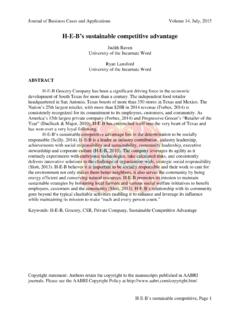Transcription of Creative-thinking exercises for entrepreneurship class
1 Journal of Business Cases and Applications Volume 12 October, 2014 Creative-thinking exercises , page 1 Creative-thinking exercises for entrepreneurship class Kimberly M. Green University of West Georgia ABSTRACT While opportunity recognition is a key component of entrepreneurship and may sound straight-forward, it is not necessarily easy to do. Students may grasp the concept of opportunity recognition but not know how to begin to accomplish it. To facilitate this understanding, this paper develops classroom exercises that offer practice in noticing the many ways that a variety of topics and contexts are related to entrepreneurship . Each exercise will not initially appear to be directly related to entrepreneurship . The basic topics for the exercises are games, nature, works of art, and geography.
2 After the students complete a brief exercise , the instructor explains a variety of ways the exercise ties to opportunities for selling products and services. The exercises are short enough that they can be used as a brief introduction, but there is sufficient complexity in the entrepreneurial concepts tied to each exercise that they could launch a discussion for a full class period. The exercises could each be used as an icebreaker for an entrepreneurship class , either at the beginning of the term or to introduce chapters or concepts during the term. Students gain insight into how looking at a topic from a variety of angles can yield multiple possibilities and ideas with business potential. The exercises are designed to demonstrate how alertness to the external environment allows an entrepreneur to identify business ideas in a variety of contexts and unique approaches to solving problems.
3 Keywords: entrepreneurship , creativity, classroom exercises , innovation, opportunity recognition Copyright statement: Authors retain the copyright to the manuscripts published in AABRI journals. Please see the AABRI Copyright Policy at Journal of Business Cases and Applications Volume 12 October, 2014 Creative-thinking exercises , page 2 INTRODUCTION The basic activity of entrepreneurship is recognizing and exploiting an opportunity (Shane & Venkataraman, 2000). The entrepreneur is central to the process, with opportunity recognition involving the interaction of the entrepreneur and the environment (Shane & Venkataraman, 2000; Shaver & Scott, 1991). An entrepreneur s ability to attend to the environment has been studied in the constructs of entrepreneurial alertness or entrepreneurial mindset (Gaglio & Katz, 2001; McGrath & MacMillan, 2000).
4 Entrepreneurs are alert to or mindful of ways to combine resources in new ways to address what they have identified as an unmet need in the market. These unique combinations of resources may be developed to address more effectively a recognized need in the market or newly address a heretofore unmet need. While opportunity recognition is a key component of entrepreneurship and may sound straight-forward, it is not necessarily easy to do. And how, in a classroom setting, can an instructor give students a feel for noticing possible connections and combinations that produce viable businesses (Kwong, Thompson, Cheung & Manzoor, 2012)? This paper suggests classroom exercises that offer practice in noticing the many ways that a variety of topics and contexts are related to entrepreneurship . These are illustrations of ways to see opportunity in a variety of places.
5 Each exercise will not initially appear to be directly related to entrepreneurship . After the students complete the brief exercise , the instructor explains a variety of ways the exercise ties to opportunities for selling products and services. The exercises can illustrate to students that the more they learn about entrepreneurship , the better able they will be to see the business connections in a topic. Students can gain insight into how looking at a topic from a variety of angles can yield multiple possibilities and ideas with business potential. An exercise could be used as an icebreaker in the first week of class , and students could work together as a way of getting to know each other or work alone and then share their answers as a way of introducing themselves. Alternatively, the exercises could be used to introduce different chapters or topics in the class throughout the school term.
6 Another approach is to use all of the exercises on one class day as a way of practicing brainstorming and creative thinking as the discussion moves from one topic to the next associated with the exercises . exercises This section presents four short exercises as they would be assigned to the students. The ties between the exercises and entrepreneurship concepts are then presented in the following section of teaching notes. Each exercise is more effective if the ties to entrepreneurship are not presented until after the students have worked on the exercise . exercise 1 This exercise is based on games. The instructor directs the students to list as many games as they can. The instructor can give a time limit (such as two minutes) or simply call time when students writing slows down. If the students ask for clarifying details such as which types of games should be included or how many games are required, the instructor should respond that all of the instructions have been given and that the students should do their best with the instructions as stated.
7 Journal of Business Cases and Applications Volume 12 October, 2014 Creative-thinking exercises , page 3 exercise 2 This exercise is based on nature. The instructor directs the students to write down the name of a flower for each letter of the alphabet ( , A = azalea, B = black-eyed Susan, C = chrysanthemum, and so on). Or, instead of flowers, the students could use trees, birds, or any animals. The exercise is equally effective with plants or animals or a combination of each. exercise 3 This exercise is based on art. Works of art and their artists are presented in a matching quiz format for this exercise . The matching format helps to eliminate careless guesses or reluctance to participate since the answers are on the page to jog the students recollection. This exercise could be used to tie in with performances, exhibits, or other arts events on campus.
8 Between ten and 20 matches typically give the students enough time to focus on the exercise . Examples of artists and their works for this exercise are as follows: (1) Charles Dickens/A Christmas Carol; (2) Tchaikovsky/The Nutcracker; (3) Jane Austen/Pride and Prejudice; (4) Langston Hughes/Not Without Laughter; (5) Mary Shelley/Frankenstein; (6) Steve Martin/The Jerk; (7) Mozart/The Magic Flute; (8) Rodin/The Thinker; (9) Alice Walker/The Color Purple; (10) Claude Monet/Water Lilies; (11) Louis Armstrong/Hello, Dolly; (12) Elvis Presley/ Jailhouse Rock. exercise 4 This exercise is based on geography and transportation topics. Students are given an outline map of the United States with the individual state borders visible. This exercise can easily be changed to a different country, a region within any country, or a region including several countries by using the appropriate map.
9 The exercise could also be focused on an area closely surrounding the students school. Using the map they are given, students are asked to locate specific items relevant to transportation and travel. In the United States, items to locate can include airports, interstate highways, bodies of water, and national parks. About four or five of each category will be sufficient coverage to illustrate the concepts of this exercise . Airports can be presented to the students using the three-letter airport code. Students find a challenge both in identifying the code and in locating the airport. Examples include LGA = LaGuardia (New York), IAD = Washington DC Dulles, ORD = Chicago O Hare, SFO = San Francisco, ATL = Atlanta. In the United States, the interstate highways are systematically numbered.
10 Odd-numbered interstates run in a north-south direction and are numbered such that the lowest number (I-5) is on the west coast and the highest number (I-95) is on the east coast. Even-numbered interstates run in an east-west direction and are numbered such that the lowest number is the farthest south (I-10) and the highest number (I-94) is the farthest north. Many students are not aware of this pattern. Therefore, it can be an effective element of this exercise to give a range of interstate numbers that span the map. Including one that the students are known to be familiar can help them get started. Examples include I-5, I-10, I-20, I-65, I-75, I-94, and I-95. Other state highways or roads of significance around the students area could also be included. Bodies of water are significant to transportation or to local economies.

















